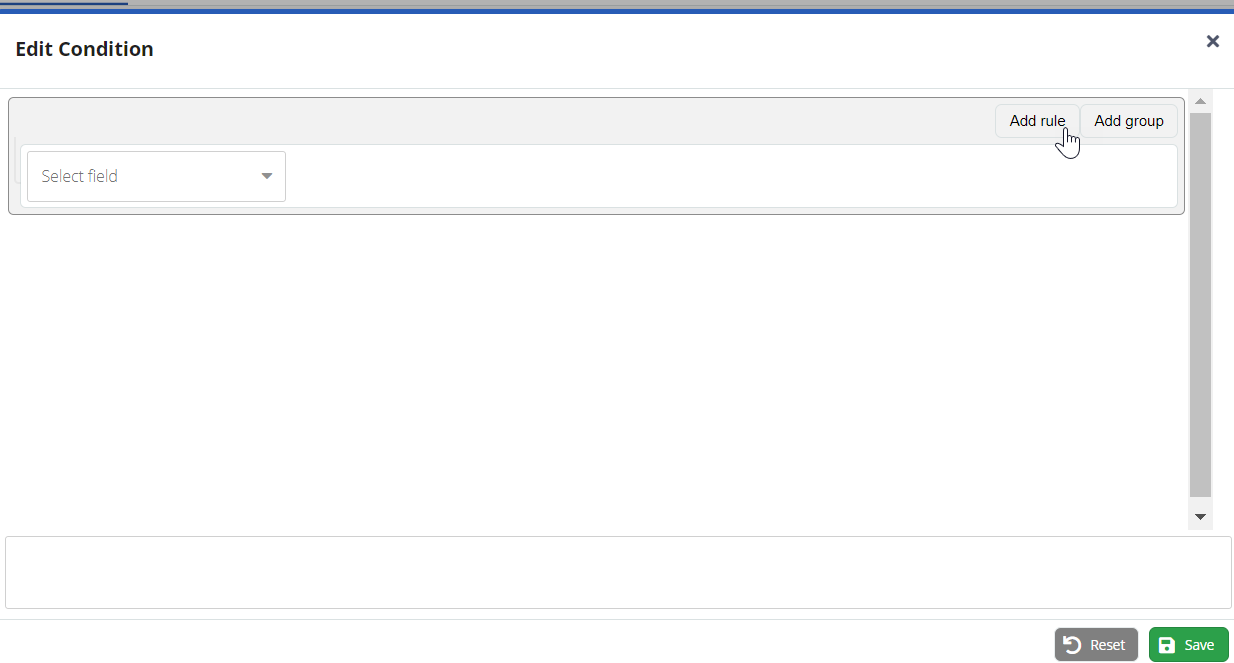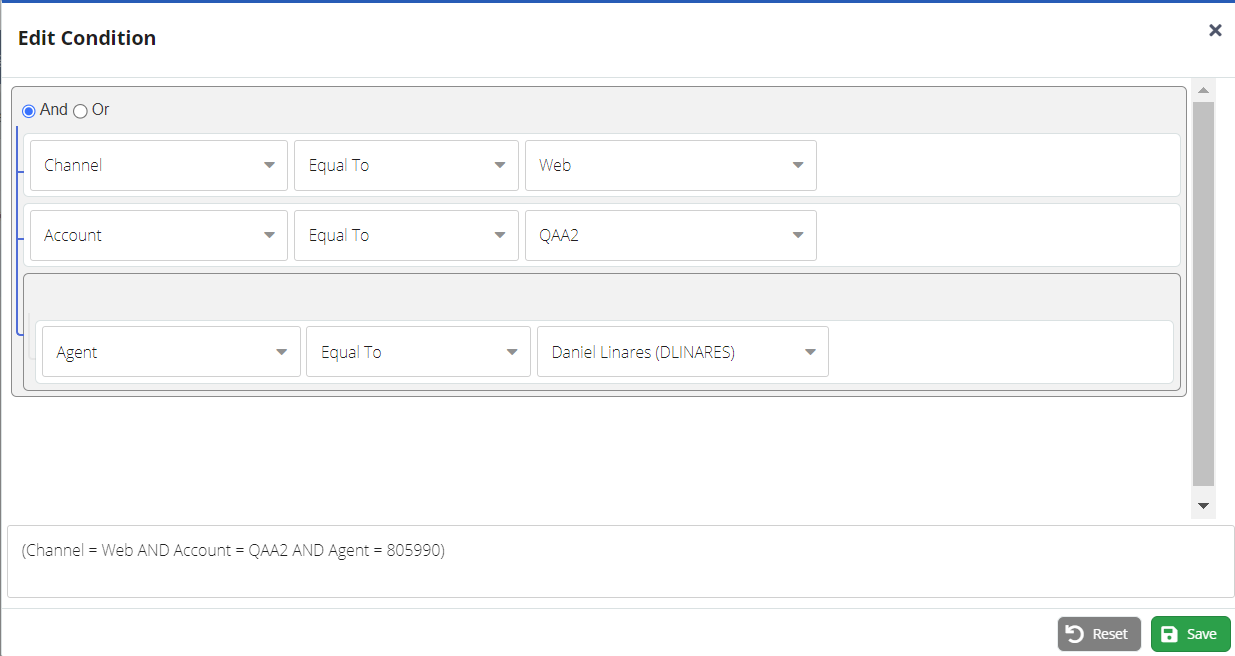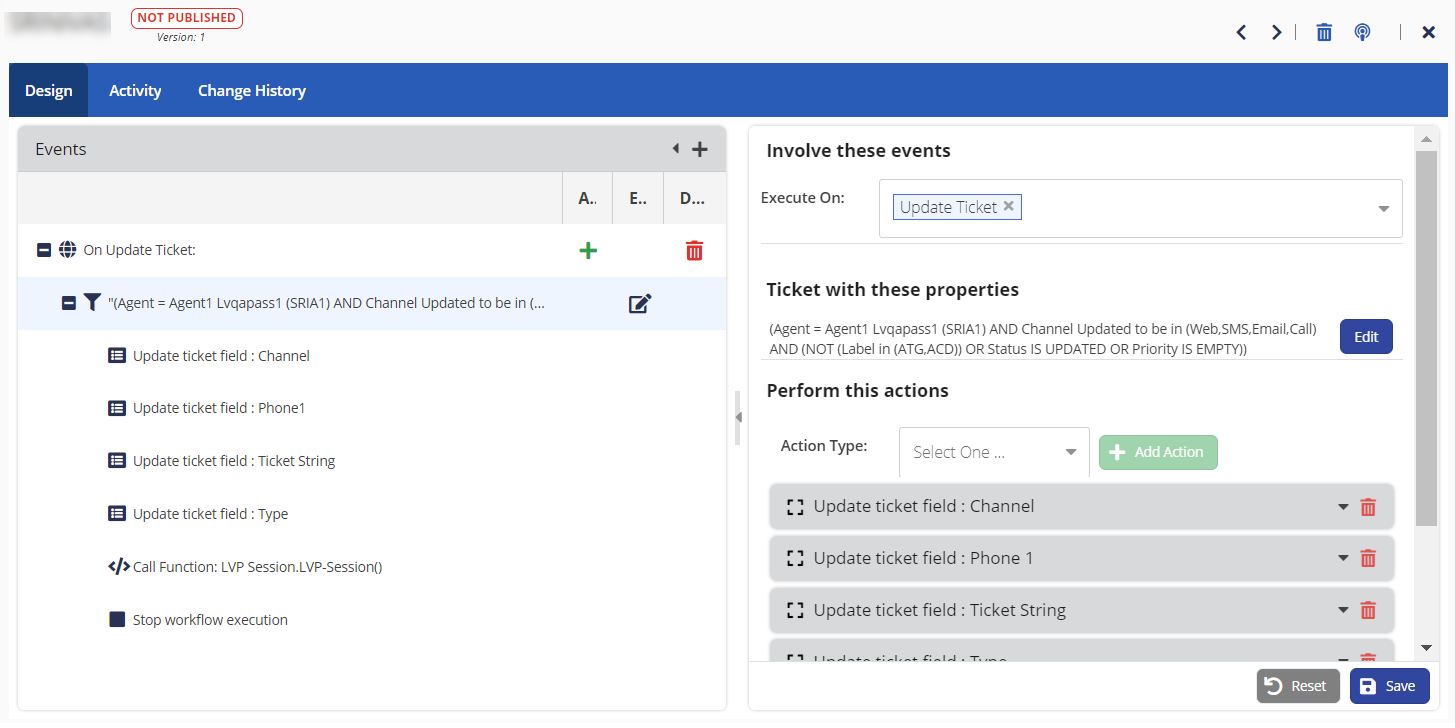Download PDF
Download page Workflows.
Workflows
A defined workflow ensures that all tickets are handled in a consistent and timely manner. You can automate a workflow for tickets so that they undergo a standard process that reduces manual work, saves time, and minimizes errors, thereby getting a quicker resolution.
The Workflows tab of the Ticketing Config window enables you to configure workflows for tickets based on certain conditions that you define when the ticket is created or updated or when a nightly run is initiated. When you set the workflow to run nightly, the process starts automatically without manual interference.
The Workflow tab consists of Design, Activity, and Change History subtabs.
Configuring the Workflows
You can configure a ticketing workflow to generate any of the following events:
- Send an email or SMS
- Create a work queue task
- Update a field in a ticket
- Call an API function
- Stop the workflow
You create a workflow for different ticket types using the Workflows tab, which consists of the following subtabs:
- Design: Enables you to configure a workflow for a form.
- Activity: Enables you to view all the tickets to which a workflow is applied.
History: Enables you to view all the changes made to a workflow.
Creating and Designing a Workflow
To create and design a workflow:
- On the Workflows tab, click New.
- Specify values in the following fields:
- Name: Name for the workflow.
Ticket Type: Ticket type to which you want the workflow to be applied (for example, bug, support, project, work order, and others).
Ensure that the value that you specify in this field is not used in the respective field of a published workflow. For example, in an existing workflow for a certain ticket type, do not create the workflow for the same ticket type, because this will overwrite the workflow.
Description: Description for the workflow.
This field is optional.
- Click Save.
The ticket workflow is created, and the Design subtab appears.
Click the New Event button.

Specify values in the following sections as required.
Section
Field
Description
Involves any of these events
Triggers Actions to trigger the workflow (for example, when the ticket is created or updated, or when a nightly run is initiated).
The Triggers field contains the following options:
- Create Ticket
- Update Ticket
- Nightly Run
When you select the Update Ticket trigger, any update in the ticket does not trigger the workflow. The workflow is triggered only when a specific field in the ticket is updated.
Tickets with these properties
Always Properties for the tickets for which you want the workflow to be applied. The default value is Always, which indicates that the workflow is applied to tickets regardless of their properties.
To modify the value:- Click Edit.
The Edit Condition window appears.
Specify properties for tickets by using the drop-down arrows and the following buttons:
Add Rule: Adds a rule.
Add Group: Adds a group for whom the conditions should be applied.
- When you add a Rule or Group, you can specify the logical operator (and/or) with which to connect the expressions by using the AND and OR links.
- To delete a Rule or Group, click the
 button next to the rule or group.
button next to the rule or group. - To revert all your changes, click Reset.
- The logic appears in the window as you specify it.

- Click Save.
Perform these actions
Action Type Resulting actions for the workflow.
The Action Type field contains the following options:
Send SMS: Sends an SMS.
SMS notifications generated through a ticket workflow are not saved in the Interaction table. In addition, they do not depend on any service, and they comply with the SMS suppression list.
- Send Email: Sends an email.
- Create WQ Task: Creates a work queue task.
- Update Ticket Field: Modifies the value in a field on the ticket.
- Call Function: Calls an API function.
- Stop Workflow Execution: Stops the workflow.
After you specify a value in the Action Type field, click Add, and then specify values in the fields that appear.
- When you add the Send SMS action, the Send SMS to section appears, displaying the following fields:
Template: Enables you to select an SMS template. The message in the selected template appears in the section.
- To: Enables you to specify a phone number or select one of the following options and then it will use the value contained to send the SMS :
- contact.phone1: Phone number of the contact associated with the ticket.
- ticket.phone1: Primary phone number associated with the ticket.
- ticket.phone2: Secondary phone number associated with the ticket.
- When you add the Send Email action, the Send Email to section appears, displaying the following fields:
Template: Enables you to select an email template. The message in the selected template appears in the section.
- To: Enables you to specify an email address number or select one of the following options:
- contact.email: Email address of the contact associated with the ticket.
- ticket.email: Email address associated with the ticket.
- CC and BCC: Enables you to add CC and BCC email addresses. This is available in both the Template and free-form options.
- When creating a work queue task, you can specify the due date and due time for the task.
Email and SMS messages generated through a ticket workflow are defined in a contact flow—in the Expressions section of the Expression Builder window, which contains the account and ticket fields (both standard and custom). For information about contact flows, see the Contact Flow Guide.
- You can delete an action by using the
 next to the action.
next to the action.
Click Save.
The workflow is created with that design, and the event appears on the Design subtab.
- For the same event (Create Ticket, Update Ticket, or Nightly Run), you can add another design (that is, specify additional ticket properties and actions for the workflow) using the
 next to the event.
next to the event. - You can modify a design using the
 next to the design.
next to the design. - You can add another event using the New Event button.
- You can delete an event using the
 next to the event.
next to the event.
- For the same event (Create Ticket, Update Ticket, or Nightly Run), you can add another design (that is, specify additional ticket properties and actions for the workflow) using the
- To filter the workflows, on the Workflows tab, in the Filter box, specify the text on which you want to filter the workflows.
- To modify a workflow, on the Workflows tab, click the row displaying the workflow, and then use the Edit button.
- To apply a workflow to a ticket, you must publish the workflow. To publish a workflow, on the Workflows tab, click the row displaying the workflow, and then click Publish. The Edit button is disabled for a published workflow.
- To copy a workflow, on the Workflows tab, click the row displaying the workflow, and then click Copy. If the workflow that you copied is already published, you cannot publish the copy unless you unpublish the copied workflow.
- To unpublish a workflow, on the Workflows tab, click the row displaying the workflow, and then click Unpublish.
- If a workflow is published, you cannot modify it unless you create another version of it. To create another version, on the Workflows tab, double-click the row displaying the published workflow, and then click New Version. The new version of the published workflow will be in the draft state. You can publish the new version; however, doing so deletes the published version.
To delete a workflow, on the Workflows tab, click the row displaying the workflow, and then use the Delete button.
Viewing the Workflow Activity
To view all the tickets attached to a workflow:
- On the Configure tab, go to Ticketing > Tickets Config.
The Ticketing Config window appears. - On the Workflows tab, double-click the workflow for which you want to view the tickets, and then click the Activity subtab.
A table with the tickets attached to that workflow appears. The table displays the following columns:- Version: Version of the workflow that was applied to the ticket.
- Executed on: Date and time when the workflow was applied to the ticket.
- Ticket: Number of the ticket.
- Ticket Name: Subject of the ticket.
- Event: Event (trigger) when the workflow was applied to the ticket (that is, when the ticket was created or updated, or when a nightly run was initiated).
- Condition:Properties of the ticket that indicate whether the workflow is applied to the ticket. The value Always indicates that the workflow is applied to the ticket regardless of its properties.
- Action: Action resulting from the workflow.
- Action Body: Details about the action.
- Version: Version of the workflow that was applied to the ticket.
To filter the tickets, specify values in the following fields, as required, and then click Search:
- Ticket Number
- Start Date and Time
- End Date and Time
Viewing the Workflow History
To view all the changes made to a workflow, including its design:
- On the Configure tab, go to Ticketing > Tickets Config.
The Ticketing Config window appears. - On the Workflows tab, double-click the workflow for which you want to view the changes, and then click the Change History subtab.
A table with the changes appears, displaying the following columns:Version: Version of the workflow on which the change was made.
If any change is made to a workflow after it is published, the version of the workflow is incremented.
- Changed on: Date and time of the change.
- Updated by: ID of the user who made the change.
Entity: Entity that was changed.
- The value WORKFLOW indicates that the workflow was changed.
- The value TRIGGER indicates that the design of the workflow was changed.
Ticket Type: Section of the workflow design that was changed.
- The value EVENT indicates that the Involves any of these events section of the design was changed.
- The value CONDITION indicates that the On tickets with these properties section of the design was changed.
- The value ACTION indicates that the Perform these actions section of the design was changed.
- Operation: Type of change made to the workflow (for example, create, update, publish, unpublish, or delete).
- Details: Description of the change.
To filter the entries, specify values in the following fields as required, and then click ![]() :
:
- Start Date
- End Date